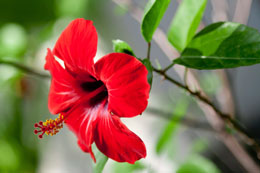The ancient study of Ayurveda lays great prominence on the use of organic herbs as natural body cleansers, and for the treatment of most ailments. This article provides information about the various herbs used in Ayurveda and their uses.

Ayurveda, is one of the oldest medical systems in the world, which originated around 3000 years ago. This ancient medicine system has a firm belief in curing the causative element of a disease, rather than suppressing its symptoms or treating it superficially. Ancient Ayurveda, bases its practices on five natural elements; they are
Akasha ( Space),
Agni (Fire),
Vayu (Air),
Jal (Water), and
Prtithvi (Earth). It links these five elements to the five human sense organs, while diagnosing and treating ailments.
List of Ayurvedic Herbs
Ayurvedic herbs are assigned and combined as per their properties and functions to prepare herbal medicines and promote health and wellness. Some of these herbs very easily available and can be grown in gardens, while some are very rare and expensive. Following is a list of herbs that are used in Ayurveda.
Aloe vera: The flowers and roots of the aloe vera plant are used topically to treat X-ray burns, dermatitis, and disorders of the skin. The herb can be consumed to reduce cholesterol, blood fat, lipid levels, etc. It is available in gel, juice, and powder form.
Bambusa vulgaris: Commonly known as bamboo, its various parts, like the leaves, exudate, and resin, are used to treat different ailments. The leaves are high in protein and are used for their cooling, astringent properties. The exudate is used to treat various inflammatory conditions and wounds.
Calendula officinalis: The common single petaled marigold has anti-inflammatory and antiseptic properties. It's used to treat various ailments such as conjunctivitis, eczema, gastritis, warts, and minor burns. As it has antifungal properties, it is known to treat ringworm and candida.
Tamarind: Tamarind roots, fruits, and seeds are widely used to cure intestinal diseases and diarrhea. Dried, powdered seeds are used to reduce severe dysentery, and the ashes of the bark are used in the treatment of digestive disorders. Tamarind pulp is used to add flavor to sauces, curries, and beverages.
Amalaki: More popularly known as the Indian gooseberry, it is known to have one of the highest natural vitamin C concentrates, among all other edible plants. It's rich in antioxidants that help protect cells against damage from free radicals. It's often used to heal respiratory infections, skin disorders, and to curb premature aging.
Black Juniper: The whole plant, including its leaves and fruit are bitter and acrid in taste. It helps remove parasitic intestinal worms and also increases appetite. It is commonly used for treating diseases of the spleen and abdomen. Oil obtained from its fruit is used to make tonics and is good for earaches and toothaches.
Triphala: This traditional herbal supplement dates back thousands of years, and is known to have a balancing and rejuvenating effect on the mind and body. It helps promote regular bowel movement, which is the best treatment for constipation. It's an excellent source bioflavonoids, vitamin C, linoleic oil, phospholipids, etc.
Hibiscus: The paste made from hibiscus leaves and flowers, are poulticed onto cancerous swellings and mumps, to relieve the pain. Its fibrous root is used in hair treatments, to control hair fall and add luster. The young, tender leaves of the plant are sometimes used as a substitute for spinach while cooking.
Ipomoea Carnea: Also known as the morning glory, this herb is known to have stimulating allelopathic effects on the mind and body. Traditional healers have used its milky juice for treating skin disorders like leucoderma. As the plant is toxic in nature, it's only used topically.
Ginger: Ginger is the most widely used herb in Ayurveda. It helps improve the digestive system and encourages assimilation and transportation of important nutrients in the body. It is recommend for relieving motion sickness, and joint pains, particularly in the early stages of rheumatoid arthritis.
One doesn't need to personally collect, quantify, and stew herbs to use them for therapeutic purposes. They are easily available in the form of tablets, powder, oils, and drops.






 Ayurveda, is one of the oldest medical systems in the world, which originated around 3000 years ago. This ancient medicine system has a firm belief in curing the causative element of a disease, rather than suppressing its symptoms or treating it superficially. Ancient Ayurveda, bases its practices on five natural elements; they are Akasha ( Space), Agni (Fire), Vayu (Air), Jal (Water), and Prtithvi (Earth). It links these five elements to the five human sense organs, while diagnosing and treating ailments.
Ayurveda, is one of the oldest medical systems in the world, which originated around 3000 years ago. This ancient medicine system has a firm belief in curing the causative element of a disease, rather than suppressing its symptoms or treating it superficially. Ancient Ayurveda, bases its practices on five natural elements; they are Akasha ( Space), Agni (Fire), Vayu (Air), Jal (Water), and Prtithvi (Earth). It links these five elements to the five human sense organs, while diagnosing and treating ailments.